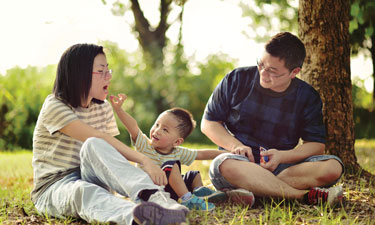 Promoting conservation and appreciation for nature is a key aspect of park and recreation programming across the country. In addition to increasing youth and families’ exposure to the great outdoors, conservation activities are wonderful opportunities to encourage children to eat better and move more!
Promoting conservation and appreciation for nature is a key aspect of park and recreation programming across the country. In addition to increasing youth and families’ exposure to the great outdoors, conservation activities are wonderful opportunities to encourage children to eat better and move more!
Here are seven activities for you to try this spring:
1 Cultivate personal awareness.
Start with a nature walk. It doesn’t matter if you’re walking down a city block or strolling around a pond — take time to reflect and reconnect with your love of the environment. Now, share that love with your students. Provide simple supplies and make nature journals with children. Encourage them to write down what they hear, smell and see. It may seem easier to just take pictures with your camera, but slowing down and writing creates a deeper impact and helps you stay connected to the earth. Turn nature journals into art projects like posters, dioramas and plays. Use these to prompt deeper explorations. Activities rooted in personal experiences will last longer and have deeper meaning.
2 Start small and let ideas grow.
The tallest sunflower starts as a seed. Find your seeds of inspiration, like making butterfly snacks with children. It’s as simple as a slice of banana with two pretzels as wings and raisin eyes. As you make this healthy snack, ask children, “When was the last time you saw a butterfly? Where was it? What was it doing? What type was it? Was it a monarch?” Now that you’ve started the conversation, explore NRPA’s Parks for Monarchs initiative. The best way to build support for such efforts is to make the issue relatable. This can be as simple as a healthy snack that starts a conversation.
3 Serve and celebrate.
Whether your agency is interested in saving monarch butterflies, beach cleanups or trail maintenance, let service to your community instigate conservation-related activities. Information about grant opportunities to fund your service-learning project is available through Youth Service America.
4 Make connections and develop new partnerships.
You don’t have to be a wellness or conservation expert to make the connection — that’s what collaboration is for. Work with university agriculture extension agents or local culinary experts to create your own healthy cookbook that highlights native plants and edible herbs. Invite a town historian to present on the local history of neighborhood parks. Does your community have a history rooted in agriculture or fishing? Explore the connection between natural resources and health. Hit the streets and have students collect oral histories from community members. Use this activity to spread awareness of your recreation agency and build support.
5 Integrate efforts and break silos.
Reach out to your school district or library and explore what partnerships might exist to further your wellness and conservation goals. Would a math or science teacher be interested in giving a presentation to your teens to help them assess and learn more about cafeteria food waste, recycling or composting? If your agency doesn’t have a community garden, perhaps discuss how to partner with your local school to build one and use the produce for healthy cooking lessons. Use conservation to bridge the divide between community agencies and programs.
6 Focus on activities children enjoy.
Let’s say your children like art projects (if you don’t know what they like, ask!). Start small, perhaps creating healthy messaging for your community center. It can be as easy as decorating your water fountains or displaying posters in your facility that encourage everyone to get outside and play. Now, build on that by exploring how public art impacts the use of parks and outdoor space. Have students research artists, photograph local spaces and brainstorm about how they could lead their own public art project to revitalize a space. Prompt students to think about how public art can be used to share positive messages that not only encourage healthy behaviors, but also social action.
7 Get hands-on.
Studying the lifecycle of animals can be fun! Children will never forget getting their hands dirty building bat houses, butterfly gardens or new beehives. Make the connection between what animals and insects need to live and the importance of children staying hydrated, getting enough sleep and eating fruits and vegetables. Share your successes by presenting to your local school board, city council or writing an article for your local newspaper.
Which of these seven activities will you try? Start small, raise youth voices, have fun and make an impact.
Daniel W. Hatcheris a National Out-of-School Advisor with the Alliance for a Healthier Generation.

